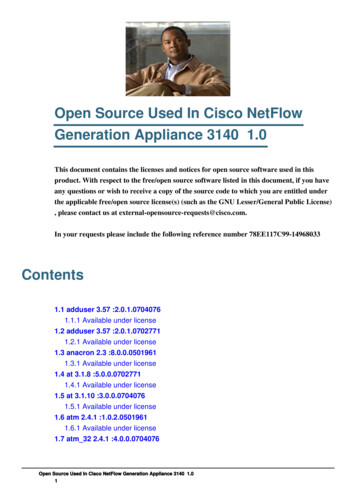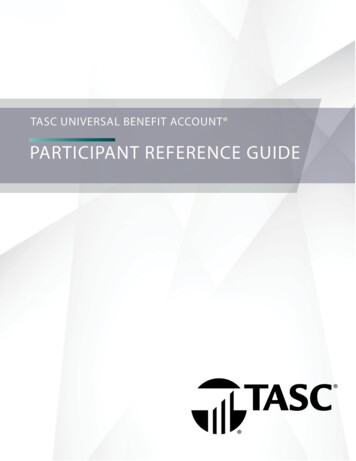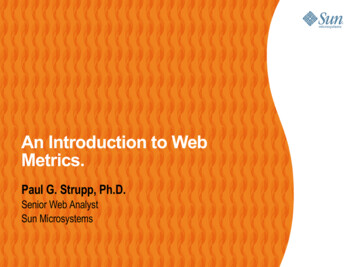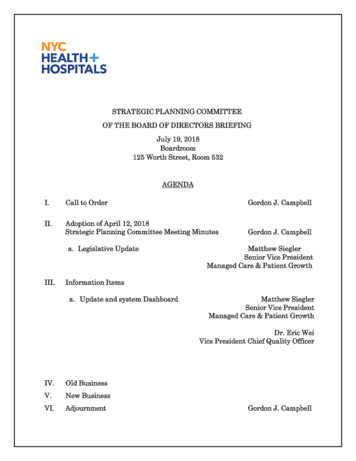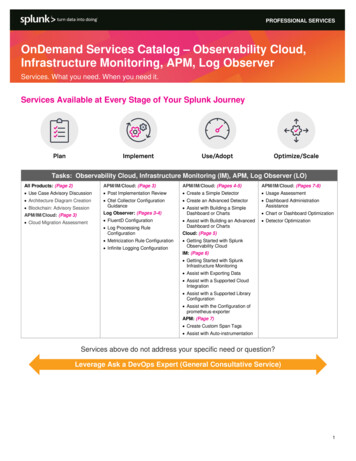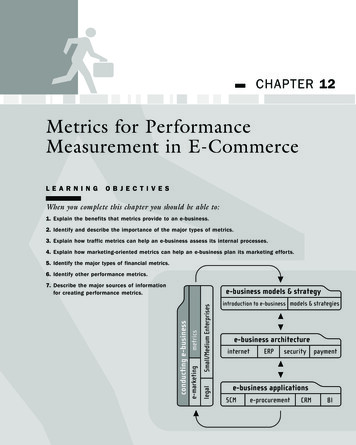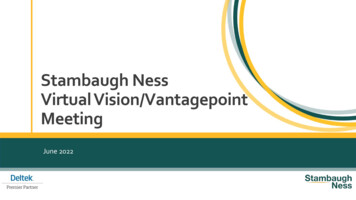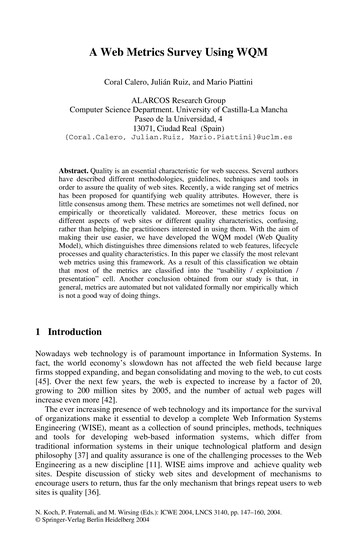
Transcription
A Web Metrics Survey Using WQMCoral Calero, Julián Ruiz, and Mario PiattiniALARCOS Research GroupComputer Science Department. University of Castilla-La ManchaPaseo de la Universidad, 413071, Ciudad Real (Spain){Coral.Calero, Julian.Ruiz, Mario.Piattini}@uclm.esAbstract. Quality is an essential characteristic for web success. Several authorshave described different methodologies, guidelines, techniques and tools inorder to assure the quality of web sites. Recently, a wide ranging set of metricshas been proposed for quantifying web quality attributes. However, there islittle consensus among them. These metrics are sometimes not well defined, norempirically or theoretically validated. Moreover, these metrics focus ondifferent aspects of web sites or different quality characteristics, confusing,rather than helping, the practitioners interested in using them. With the aim ofmaking their use easier, we have developed the WQM model (Web QualityModel), which distinguishes three dimensions related to web features, lifecycleprocesses and quality characteristics. In this paper we classify the most relevantweb metrics using this framework. As a result of this classification we obtainthat most of the metrics are classified into the “usability / exploitation /presentation” cell. Another conclusion obtained from our study is that, ingeneral, metrics are automated but not validated formally nor empirically whichis not a good way of doing things.1 IntroductionNowadays web technology is of paramount importance in Information Systems. Infact, the world economy’s slowdown has not affected the web field because largefirms stopped expanding, and began consolidating and moving to the web, to cut costs[45]. Over the next few years, the web is expected to increase by a factor of 20,growing to 200 million sites by 2005, and the number of actual web pages willincrease even more [42].The ever increasing presence of web technology and its importance for the survivalof organizations make it essential to develop a complete Web Information SystemsEngineering (WISE), meant as a collection of sound principles, methods, techniquesand tools for developing web-based information systems, which differ fromtraditional information systems in their unique technological platform and designphilosophy [37] and quality assurance is one of the challenging processes to the WebEngineering as a new discipline [11]. WISE aims improve and achieve quality websites. Despite discussion of sticky web sites and development of mechanisms toencourage users to return, thus far the only mechanism that brings repeat users to websites is quality [36].N. Koch, P. Fraternali, and M. Wirsing (Eds.): ICWE 2004, LNCS 3140, pp. 147–160, 2004. Springer-Verlag Berlin Heidelberg 2004
148C. Calero, J. Ruiz, and M. PiattiniHowever, and perhaps because the quality of web sites is not universally definableand measurable [9] their quality is not always assured [2, 10].In recent years several experts have worked on different proposals to improve webquality: methodologies [39], quality frameworks [13, 25], estimation models [28],criteria [50], usability guidelines [34], assessment methods [49] and metrics.In fact, web metrics is a particularly valuable area of ongoing commerciallyrelevant research [47]. Since the nineties, a wide ranging set of metrics has beenproposed for quantifying web quality attributes [1, 3, 5-7, 12, 14, 17, 18, 22-24, 2631, 33, 38-41, 44-46, 51].However, these metrics are sometimes not well defined and neither empirically northeoretically validated. All these metrics, focused on different aspects of web sites ordifferent quality characteristics, can confuse, rather than help, the practitionersinterested in using them.With the aim of classifying these metrics and making their use easier, we haveelaborated the WQM model (Web Quality Model), which distinguishes threedimensions related to web features, lifecycle processes and quality characteristics[48].Recently, Dhyani et al. [12] proposed a web classification framework usingdifferent categories: web graph properties, web page significance, usagecharacterization, web page similarity, web page search and retrieval, and theoreticalinformation. The authors try to determine how the classified metrics can be applied toimproving web information access and use. However they discard other importantdimensions such as lifecycle and web features which are included in our model.Moreover in this survey they do not consider some very interesting metrics such as[24, 28, 38].In the following section we present the WQM model explaining each of itsdimensions. In the third section we will summarize the result of the classification ofthe most relevant web metrics. Conclusions and future work will appear in the lastsection.2 Dimensions in Web QualityIn Ramler et al. [43] the authors define a cube structure in which they consider threebasic aspects when making a test of a web site. Following this idea, in Ruiz et al. [48]we proposed another “cube” in which the three dimensions represent those aspectsthat must be considered in the evaluation of the quality of a web site: features, lifecycle processes and quality aspects, which can be considered orthogonal. We haveused this model to classify different studies on web engineering and we have refinedour dimensions. In this section we will summarize the last version of the WQM,which is represented in figure 1.2.1 Web Features DimensionIn this dimension we include the three “classic” web aspects: Content, Presentationand Navigation [6, 15, 16]. Navigation is an important design element, allowing users
A Web Metrics Survey Using WQM149Web FeaturesContentQuality NavigationMaintenanceLifecycle ProcessesFig. 1. Graphic representation of the model.to acquire more of the information they are seeking and making that informationeasier to find. Presentation and content are prime components in making the pageeasier to use [42].In Content we have included not only data such as text, figures, images, videoclips, etc, but also programs and applications that provide functionalities like scripts,CGI programs, java programs, and others. Content also deals with structure andrepresentation issues. Due to the close intertwining of functions and data the borderbetween them is not clearly drawn, and we consider them the same feature.Navigation concerns the facilities for accessing information and for moving aroundthe web.Presentation is related to the way in which content and navigation are presented tothe user.2.2 Quality Characteristics DimensionFor the description of this dimension we use as a basis the Quint2 model [35] basedon the ISO 9126 standard [20]. We have decided to use Quint2 instead of the standardbecause this model extends the ISO standard with new characteristics veryappropriate for web products. Quint2 is a hierarchical model that fixes six basiccharacteristics, each one of them with a set of subcharacteristics, to which a set ofattributes is associated. These are the basic elements. Table 1 shows thecharacteristics of Quint2, indicating, if necessary, those subcharacteristics added orremoved respect to ISO 9126.There is also a compliance subcharacteristic for all characteristics (attributes ofsoftware that make it adhere to application related standards, conventions in laws andsimilar prescriptions).
150C. Calero, J. Ruiz, and M. PiattiniTable 1. Model Quality Characteristics
A Web Metrics Survey Using WQM1512.3 Life Cycle Processes DimensionBy introducing this dimension, we believe that we are also considering the peopleinvolved in the development who have different skills and therefore differentpriorities and attitudes [32] are included. For example, the developer’s interests areconsidered in the development process.So, in this dimension we include the diverse processes of the web site life cyclefollowing the ISO 12207-1 standard [19]. In the current version of the model we onlyincluded three main processes: the development process, the exploitation process(which includes the operative support for users) and the maintenance process (whichincludes the evolution that the web site undergoes).It is important to emphasize that the activities of these processes must not bedeveloped sequentially, because, due to the characteristics of web development, it willbe necessary to use more iterative models and even more flexible developmentswithout following formal methodologies [4].3 Analysis of Existing Metrics3.1 Surveyed MetricsFor the present study, we have surveyed different studies of metrics related in somemanner with web topics. We have reviewed about 60 papers, from 1992 to 2003.From all these we have selected the ones (about 40) where metric proposals(considered useful for classification purposes on WQM) were included, discardingsome others where the proposed metrics were not really applicable in our context ordid not provide any relevant information. Examples of the discarded metrics includeall the process metrics, focusing our work only on product metrics. We also discardedrepeated metrics, i.e., those metrics proposed by more than one author.We included each metric only once. 326 metrics were selected, and are listed at theend of this paper. Finally, we wish to note that the process of classifying metrics isnot a simple task and we are conscious that some of the assignments may be arguable.3.2 Filling the Cells of the CubeAlthough the model does not restrict the number of cells that can be assigned to agiven metric m, for the sake of simplicity and practicality we tried to minimize thisnumber by assigning the metrics to the cells where they could be most useful. Toavoid unnecessary complexity, we decided to show in the WQM only the qualitycharacteristic assigned, instead of the precise sub-characteristic.Assigning metrics to life cycle processes was not easy. We have given somespecial consideration to exploitation and maintenance. In the web world, wheretypical timeline in web development is 3-6 months [44], it is difficult to distinguishwhen exploitation finishes and maintenance begins. In case of doubt we haveclassified metrics in both processes.
152C. Calero, J. Ruiz, and M. Piattini3.3 The Resulting CubeDue to the extent of the detailed assignments of metrics to cells, this information isincluded at the end of this paper.In this section we will summarize the main figures of our classification shown intable 2. The “% Absolute” row shows the percentage of metrics classified on eachvalue dimension and the sum of these values is greater than 100% because, as wehave already explained, a metric can be classified in more then one cell in the cube.Because of this we have extracted prorated values shown in the “% Prorated” row.Table 2. Metrics Classification.Web FeaturesContentTotal% Absolute% Prorated9930%29%Presentation17955%52%Quality CharacteristicsNaviga- Functio- leProcessesMainUsa- Effici- PortaDevelop- Exploi Maintetainbility ency bilitymenttation nanceability26381%53%4714%9%407912% 24%8% 16%6420%13%26782%54%16250%33%Figure 2 shows metric distribution over the three dimensions of the model: webfeatures, quality characteristics, and lifecycle processes, using prorated figures. Thenext subsections present several conclusions that we can extract from it.3.3.1 Web Features DimensionAbout 52% of the metrics were “presentation” metrics. This value confirms thetendency in the web world to give it the greatest importance, making the sites asattractive as possible for the end user.At this point it is convenient to remark that usually there is a confusion betweenpresentation and navigation [6] so, perhaps the results of the navigation could varydepending on the person who makes the classification.3.3.2 Quality Characteristics DimensionMost of the metrics (53%) are usability metrics. We have to take into account that thisdata is prorated, because if we examine absolute data (table 2) we can see that 81% ofmetrics are related to usability. Again this value confirms the end-user focus trying todesign usable web sites that attract users.However, it is curious that only 4% of metrics focus on reliability, when thischaracteristic it is also extremely important for customer acceptance of web sites.Finally, we think that the appearance of new devices (such as PDA, mobiles, )will encourage the definition of new portability metrics.3.3.3 Life-Cycle DimensionWith respect to life cycle, the exploitation and maintenance processes are the oneswith most metrics. These results can be justified by taking into account theevolutionary nature of the web. The fact that there are not too many metrics defined
A Web Metrics Survey Using WQM153Fig. 2. Metric Distribution across the Model Dimensionsfor the development process can be explained because getting their software to themarket first is the top priority for firms doing business on the web and so, rather thandevelop software from requirements through the waterfall, web developments firmstry to use rapid application development methods and continuous prototyping [44].3.4 Metrics PropertiesWe have also evaluated the metrics considering the following properties [8]: Granularity Level, depending on whether the metric focuses on a singleweb page or on a web site. Theoretical Validation helps us to know when and how to apply metrics. Empirical Validation, with the objective of proving the practical utility ofthe proposed metrics. Automated Support, i.e., whether or not there is a support tool thatfacilitates the calculation of the metrics.The results of this evaluation are shown at the end of this document.As we can see there is a balanced distribution of metrics defined for web pages(47%) and web sites (53%).
154C. Calero, J. Ruiz, and M. PiattiniThe results of the validation confirm that, unfortunately, web metric validation isnot considered as a major issue, especially theoretical validation (4%) but also,empirical validation (32%).A large number of metrics are automated (79%). This is very important if we wantto incorporate the metrics into web development and maintenance projects.4 Conclusions and Future WorkThere are many metric proposals for web quality, but no consensus has been reachedfor their classification. To advance in this area, it is essential to rely on a model thatallows us to classify and systematize metric use. In this paper we have presented theWQM and we have surveyed the most relevant web metrics.Nevertheless, this is only a first approach that needs to be reviewed until adefinitive and complete version is reached that can be used with total reliability andguarantee of success.Regarding the model, some modifications could be carried out in the life cycledimension including a project process (following the standard ISO 15288, SystemLife Cycle Processes [21] in order to include in the WQM proposals related to webestimation effort like Mendes et al. [28-31]. We think this point is particularlyinteresting because as remarked in Reifer [44] web developments are hard to estimateand many professionals try to avoid this difficulty by using the more traditionalprocesses, metrics and models for estimating web projects. However, these traditionalapproaches do not seem to address the challenges facing the field.It could also be interesting to consider the metrics related to cost estimationbecause this is an essential element for providing competitive bids and remainingsuccessful in the market [47].Regarding the metrics classified in this study, we do not claim this survey to becomplete. It would be necessary to make an even more exhaustive study of the stateof the art. We also intend to define new metrics in those “cells” in which thenonexistence of metrics is detected.Acknowledgements. This research is part of the TAMANSI project (PCB-02-001)and the MESSENGER project (PCI-03-001) supported by the Consejeria de Ciencia yTecnología of Junta de Comunidades de Castilla-La Mancha (Spain) and the CALIPOproject (TIC 2003-07804-C05-03) supported by the Ministerio de Ciencia yTecnologia.References1.2.Abrahão, S., Condori-Fernandez, N., Olsina, L., Pastor, O. (2003a) Defining andValidating Metrics for Navigational Models. Ninth International Software MetricsSymposium (METRICS'03), IEEE. pp. 200-210Abrahão, S., Pastor, O. (2003b) Calidad de Sistemas Web. En: Calidad en el Desarrollo ymantenimiento del software. Madrid, Ed. Ra-Ma (spanish).
A Web Metrics Survey Using 21.22.23.24.25.155Alves de Silva, E.A., Ponti de Mattos Fortes, R. (2001) Web Quality Metrics: An AnalysisUsing Machine Learning Systems. International Conference on Information Systems,Analysis and Sintesis. World Multiconference on Systemics, Cybernetics and Informatics.Information Systems Technology. SCI 2001/ ISAS 2001. Volumen XI.Avison, D. E., Fitzgerald, G. (2003). Where Now for Development Methodologies?Communications of the ACM, 46 (1). pp 79-82.Bajaj, A., Krishnan, R. (1999) CMU-WEB: A Conceptual Model for Designing UsableWeb Applications. J. Database Manag. 10(4). pp 33-43Baresi, L., Morasca, S., Paolini, P. (2003) Estimating the Design Effort of WebthApplications. Proc. 9 International Metrics Symposium (METRICS’03) IEEE. pp. 62-72Botafogo, R., Rivlin, E., Shneiderman, B. (1992) Structural analysis of hypertexts:Identifying hierarchies and useful metrics. ACM Trans. Inform. Systems, 10(2). pp 142-180, Apr.Calero,C., Piattini, M., and Genero, M. (2001). Empirical Validation of ReferentialIntegrity Metrics. Information Software and Technology. Special Issue on ControlledExperiments in Software Technology. Vol. 43, Nº 15. 2001. pp. 949-957Ciancarini, P. and Moretti, R. (2003) Towards a framework for web sites qualitythevaluation. 15 International conference on Software Engineering and knowledgeEngineering. 1-3 July 2003. San Francisco, California. pp 721-725Cutter Consortium, (2000) Poor Project Management – Problem of E-Projects. October2000, http://www.cutter.com/press/001019.htmlDeshpande, Y., Murugesan, S., Ginige, A., Hansen, S., Schwabe, D., Gaedke, M. AndWhite, B (2002). Web Engineering. Journal of Web Engineering, Rinton Press, US, 1(1),pp. 61-73.Dhyani, D., NG, W.K. and Bhowmick, S.S. (2002). A Survey of Web Metrics. ACMComputing Surveys, 34 (4). pp 469-503.Donaldson, A.J.M., Cowderoy, A.J.C. (1997). Towards Multimedia Systems Quality.ESSI-SCOPE conference, Dublin.Fink D. (2001) Web Site Effectiveness: A Measure of Information and Service Quality,Information Resource Management Association International Conference, Toronto,Canada. pp. 144-147Fraternali, P. (1999) Tools and Approaches for Developing Data-Intensive WebApplications: A survey. ACM Computing Surveys, Vol 31, No. 3, Sept. pp. 227-263Gómez, J., Cachero, C., Pastor, O. (2001). Conceptual Modeling of Device-Independentweb applications. IEEE Multimedia. April-June 2001. pp. 26-39Herder, E. (2002) Metrics for the Adaptation of Site Structure. Proc. of the GermanWorkshop on Adaptivity and User Modeling in Interactive Systems ABIS02 - Hannover,pp. 22-26Herzinger M. (2001) Hyperlink Analysis for the web. IEEE Internet Computing, Jan-Feb.ISO/IEC (1995) ISO/IEC 12207. Information Technology. Software Life Cycle Processes.ISO/IEC (2001a) ISO/IEC 9126. Software Product Evaluation-Quality Characteristicsand Guidelines for their Use.ISO/IEC (2001b) ISO/IEC 15288. Systems Engineering – System Life Cycle Processes.Ivory, M., Hearst, M. (2001) The State of the Art in Automating Usability Evaluation ofUser Interfaces. ACM Comput. Surv. Vol. 33, No. 4. pp 470-516.Ivory, M.Y., Sinha, R.R., Hearst, M.A. (2001) Empirically Validated Web Page DesignMetrics, SIGCHI. Conference on Human Factors in Computing Systems, March 2001 pp.53-60Ivory, M.Y. (2001) An Empirical Foundation for Automated Web Interface Evaluation.PhD Thesis, University of California, Berkeley, Computer Science Division, 2001.Katterattanakul, P. and Siau, K. (2001). Information Quality in Internet CommerceDesign. In “Information and database quality”. Kluwer Academic. pp. 45-56
156C. Calero, J. Ruiz, and M. Piattini26. Lafuente, G., González, J., Olsina, L. (2001) Automatizando Métricas Web, 4º Encontropara a Qualidade nas Tecnologias de Informação e Comunicações (QUATIC), Lisboa,Portugal, pp.17-24.27. Mendes, E., Counsell, S. (2000) Web Development Effort Estimation using Analogy.Proceedings of the 2000 Australian Software Engineering Conference - ASWEC 2000,April 28-April 30, Australian National University, Canberra, ACT, Australia, IEEE CSPress. pp. 203-212.28. Mendes, E., Mosley, N., Counsell, S. (2001) Web metrics - Metrics for estimating effort todesign and author Web applications. IEEE MultiMedia, special issue on WebEngineering, January-March, pp. 50-57.29. Mendes, E, Mosley, N., Counsell, S. (2002a) Comparison of Web size measures forpredicting Web design and authoring effort. IEE Proceedings - Software 149(3). pp 86-92.30. Mendes, E., Watson, I., Trigss, C., Mosley, N., Counsell, S. (2002b) A Comparison ofDevelopment Effort Estimation Techniques for Web Hypermedia Applications.Proceedings IEEE Metrics June, Ottawa, Canada. pp. 131-140.31. Mendes, E., Mosley, N., Counsell, S. (2003) Early Web Size Measures and EffortPrediction for Web Costimation. Proc. 9th International Metrics Symposium(METRICS’03). pp. 18-29.32. Mich, L., Franch, M. and Gaio, L. (2003) Evaluating and Designing Web Site Quality.IEEE Multimedia. January-March 2003. pp. 34-43.33. Morisio, M., Stamelos, I., Spahos, V. Romano, D. (1999 ). Measuring Functionality andProductivity in Web-Based Applications: A Case Study. Sixth IEEE InternationalSymposium on Software Metrics, November. pp. 111-11834. Nielsen, J. (2000). Designing web usability. Ed. New Riders.35. Niessink, F. (2002) Software Requirements: Functional & Non-functional SoftwareRequirements. www.cs.uu.nl/docs/vakken/swa/ Slides/SA-2-Requirements.pdf36. Offutt (2002). Quality attributes of web software applications. IEEE Software. MarchApril, pp. 25-3237. Oinas-Kukkonnen, H., Alatalo, T., Kaasila, J., Kivelä, H and Sivunen, S. (2001)Requirements for web engineering methodologies. In Information Modelling in the NewMillenium. Rossi and Siau (eds). Idea Group Publishing. Pp. 360-38238. Olsina, L. (2000) Quantitative Methodology for Evaluation and Comparison of Web SiteQuality, PhD Thesis, Ciencias Exactas School, UNLP, La Plata, Argentina, 2000.39. Olsina, L., Lafuente, G., Rossi, G. (2001) Specifying Quality Characteristics andAttributes for Websites. Web Engineering: Managing Diversity and Complexity of WebApplication Development. Springer-Verlag, June, pp. 266-277.40. Olsina L., Rossi G. (2002) Measuring Web Application Quality with WebQEM, IEEEMultimedia, October-December, pp. 20-29.41. Olsina, L., Martín M., Fons, J., Abrahão, S., Pastor, O. (2003) Towards the Design of aMetrics Cataloging System by Exploiting Conceptual and Semantic Web Approaches.Proc. of the International Conference on Web Engineering (ICWE 2003), LNCS 2722, pp.324-333.42. Palmer, J. (2002) Web Site Usability, Design and Performance Metrics, InformationSystems Research, June, 13(2), pp. 151-167.43. Ramler, R., Weippl, E., Winterer, M., Shwinger, W., Altmann, J. (2002). A Quality-DrivenApproach to Web Testing. Iberoamerican Conference on Web Engineering, ICWE’02.Argentina. September. Vol. 1. pp. 81-95.44. Reifer, D. (2000) Web Development: Estimating Quick-to-Market Software. IEEESoftware, Nov-Dec. pp. 57-64.45. Reifer, D. (2002) Ten Deadly Risks in Internet and Intranet Software Development. IEEESoftware, March-April. pp. 12-14.46. Rivlin, E., Botafago, R., Shneiderman, B. (1994) Navigating in hyperspace: Designing astructure-based toolbox, Communications of the ACM, Vol. 37, No. 2, February, pp. 8796.
A Web Metrics Survey Using WQM15747. Ruhe, M., Jeffery, R., Wieczorek, I. (2003) Using Web Objects for Estimating SoftwarethDevelopment Effort for Web Applications. Proc. 9 International Metrics Symposium(METRICS’03) IEEE. pp. 30-3948. Ruiz, J., Calero, C. and Piattini, M. (2003). A Three Dimensional Web Quality Model.Proc. of the International Conference on Web Engineering (ICWE’03), LNCS 2722, pp.384-385.49. Schubert, P. (2003). Extended Web Assessment Method (EWAM) – Evaluation ofElectronic Commerce Applications from the Customer’s viewpoint. International Journalof Electronic Commerce, Vol. 7, No. 2, Winter 2002-2003, pp. d/11850. W3C (1999) WWW Consortium: Web Content Accessibility Guidelines 1.0, W3CWorking Draft. http://www.w3.org/TR/WCAG10/51. Warren, P., Gaskell, C., Boldyreff, C., Preparing the Ground for Website MetricsrdResearch. Proc. 3 International Workshop on Web Site Evolution (WSE’01). IEEE 2001.
158C. Calero, J. Ruiz, and M. Piattini
A Web Metrics Survey Using WQM159
160C. Calero, J. Ruiz, and M. Piattini
In fact, web metrics is a particularly valuable area of ongoing commercially relevant research [47]. Since the nineties, a wide ranging set of metrics has been proposed for quantifying web quality attributes [1, 3, 5-7, 12, 14, 17, 18, 22-24, 26-31, 33, 38-41, 44-46, 51]. However, these metrics are sometimes not well defined and neither .
